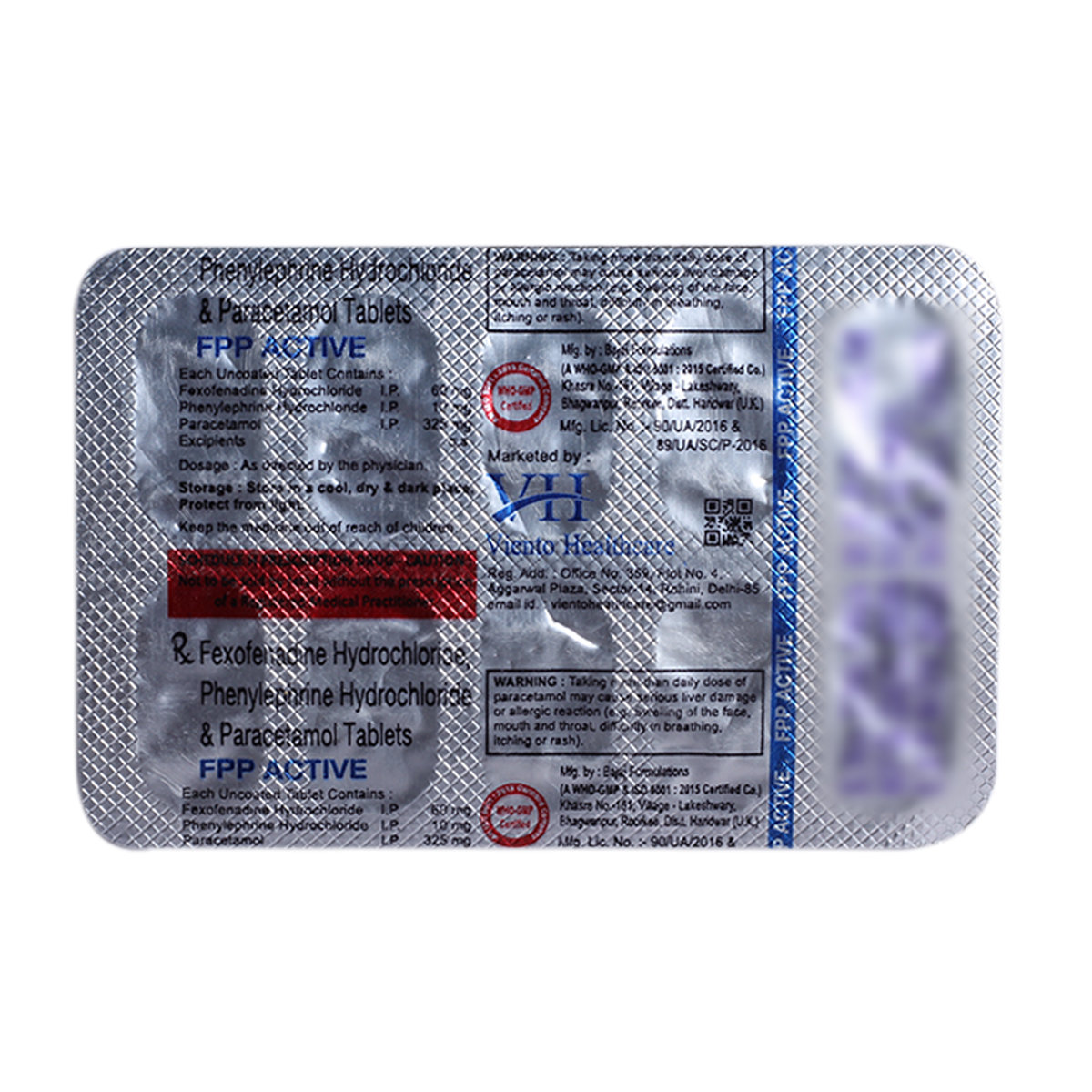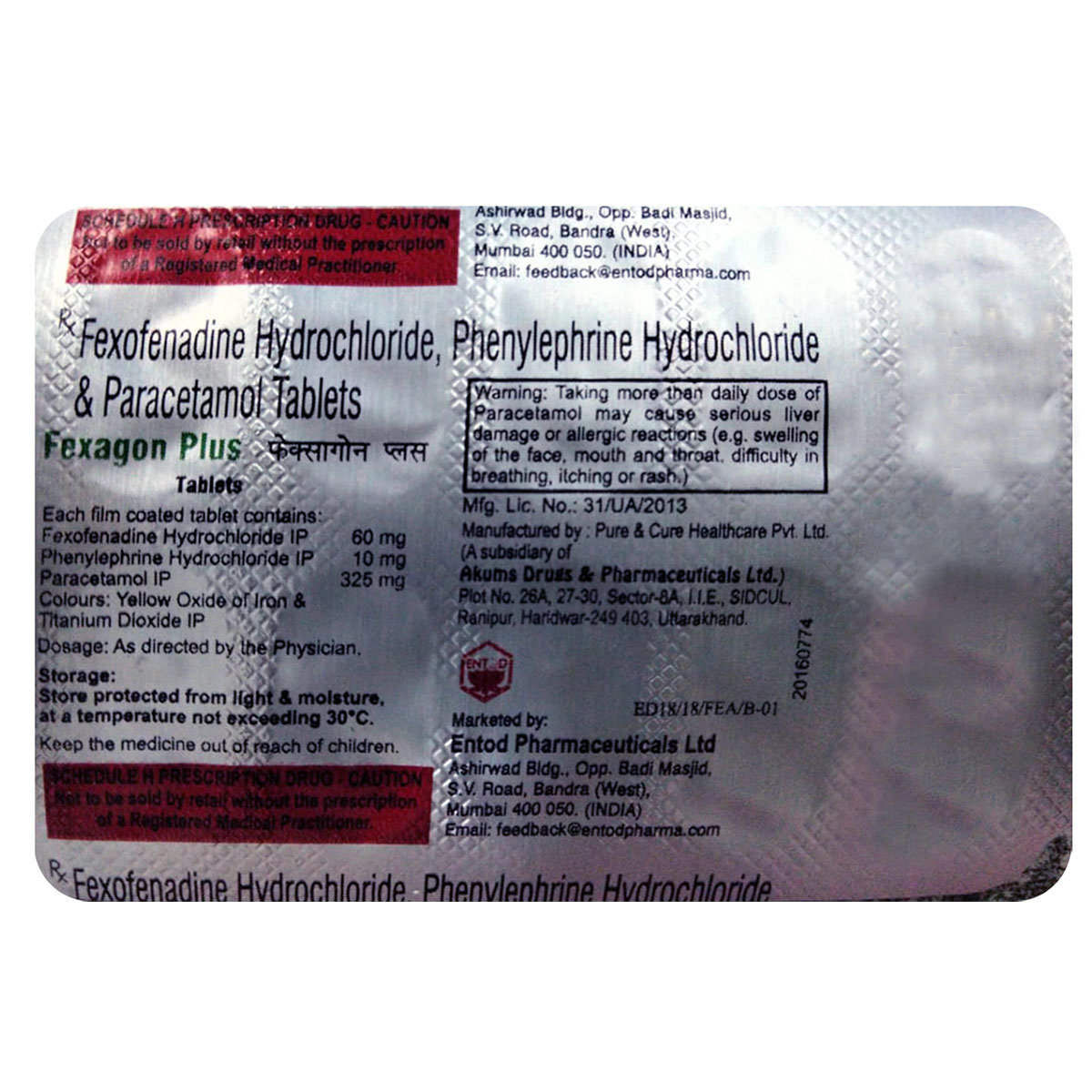Fexofenadine+phenylephrine
About Fexofenadine+phenylephrine
Fexofenadine+phenylephrine treats sneezing and a runny nose due to allergies. It works by blocking the action of histamines, substances in the body responsible for triggering allergic symptoms. Additionally, it reduces nasal swelling, alleviates symptoms like nasal congestion, and enables easier breathing, helping you feel more comfortable.
Fexofenadine+phenylephrine contains Fexofenadine and Phenylephrine. Fexofenadine is an antiallergic medicine. It blocks the release of histamine, chemical substances that cause allergic symptoms such as runny nose, watery eyes, itching, sneezing, and swelling or congestion. Phenylephrine is a decongestant that can reduce swelling in the nasal passages, making breathing easy.
You should give this medicine exactly as the doctor prescribed it. The common side-effects of Fexofenadine+phenylephrine are dryness in mouth, headache, nausea, vomiting, tiredness and drowsiness. These side effects usually go away without requiring any medical attention. However, if any of these side effects persist or get worse, inform your doctor immediately.
If your child is allergic to any contents of it, please tell the doctor. Fexofenadine+phenylephrine should be used only in doses prescribed by a doctor for children. It is recommended that you complete the full course of Fexofenadine+phenylephrine as prescribed by the doctor, even if your child feels better after a few days. Before using Fexofenadine+phenylephrine, inform your doctor if your child ever had an allergy to Fexofenadine+phenylephrine, or has a history of liver/kidney problems, heart disease, diabetes and seizures.
Uses of Fexofenadine+phenylephrine
Medicinal Benefits
Fexofenadine+phenylephrine contains a combination of Fexofenadine and Phenylephrine. Fexofenadine is an antihistamine that works by blocking the action of histamine, a substance that triggers allergic reactions. It helps relieve allergy symptoms such as sneezing, a runny nose, watery eyes, itching, swelling, and nasal congestion. Phenylephrine helps shrink the blood vessels in the nostrils and the nasal passage and reduces stuffy nose. Together, Fexofenadine+phenylephrine effectively relieves sneezing and runny nose caused by allergies.
Directions for Use
- Fexofenadine+phenylephrine can be given with or without food as advised by your doctor.
- Follow your doctor's instructions regarding the dosage and duration of the medication.
- Shake well before use. Administer the advised dose to the child using the measuring cup/measuring spoon/dropper.
- Avoid using regular household spoons, as they may not measure the dose correctly.
Side Effects of Fexofenadine+phenylephrine
- Dryness in mouth
- Headache
- Nausea
- Vomiting
- Tiredness
- Drowsiness
Drug Warnings
If your child is allergic to Fexofenadine+phenylephrine or any other medications, please inform your doctor. Before administering Fexofenadine+phenylephrine, let your doctor know if your child has any liver or kidney issues, heart disease, diabetes, or a history of seizures. It is important to complete the entire course of Fexofenadine+phenylephrine as prescribed by your doctor to ensure effective results.
Drug Interactions
Drug-Drug Interaction: Fexofenadine+phenylephrine may interact with antacids (magnesium hydroxide and aluminum hydroxide), Antibiotics (erythromycin) and antifungal medications (ketoconazole).
Drug-Food Interaction: Avoid giving fruit juices, such as grapefruit, orange, and apple juices, as they may reduce the effectiveness of Fexofenadine.
Drug-Disease Interaction: Fexofenadine+phenylephrine should be used with caution in patients with liver or kidney disease, diabetes, heart disease and seizures.
Drug-Drug Interactions Checker List:
Safety Advice

Alcohol
not applicable-

Pregnancy
not applicable-

Breast Feeding
not applicable-

Driving
not applicable-

Liver
cautionFexofenadine+phenylephrine should be used cautiously in children with liver disease as it may affect liver function. So, inform your doctor about your child's medical condition. Your doctor may adjust the dose based on the condition of your child.

Kidney
cautionInform your doctor if your child has kidney problems, as Fexofenadine+phenylephrine should be used with caution in children with pre-existing or a history of kidney conditions.

Children
safe if prescribedFexofenadine+phenylephrine can be given safely to children. Give this medicine to your child in the doses prescribed by the paediatrician.
Habit Forming
Diet & Lifestyle Advise
- Fruit juices, such as grapefruit, orange, and apple juices, may reduce the effectiveness of Fexofenadine+phenylephrine.
- Encourage your child to drink plenty of fluids to help alleviate symptoms like cough and runny nose.
- Limit exposure to known allergens such as pollen, dust, and certain foods that may trigger allergic reactions.
- Regular handwashing and keeping the living environment clean can help prevent infections.
Patients Concern
Disease/Condition Glossary
Sneezing: Sneezing, also known as sternutation, is a reflex that expels air from the nose and mouth to remove irritants, allergens, or germs from the nasal passages. This reflex occurs when the lining of the nasal passages is irritated, prompting the brain to trigger a sneeze response. Common causes of sneezing include allergens like pollen and dust, irritants such as smoke and strong scents, illnesses like the common cold or flu, and exposure to cold air. Sneezing often occurs alongside a runny nose or itching, serving as a protective mechanism for respiratory health. Frequent sneezing may indicate the presence of allergies or an infection.
Runny Nose: The excessive release of mucus from the nasal passages, known as a runny nose (rhinorrhea), is frequently brought on by sinusitis, nasal polyps, allergies, irritants (such as smoke and pollution), or infections (such as the flu and common cold). Sneezing, postnasal drip, and nasal congestion are possible symptoms.
FAQs
Fexofenadine+phenylephrine is used to treat symptoms of sneezing and runny nose due to allergies.
Fexofenadine+phenylephrine contains Fexofenadine and Phenylephrine. Fexofenadine is an antiallergic medicine. It blocks the release of histamine, chemical substances that cause allergic symptoms such as runny nose, watery eyes, itching, sneezing, and swelling or congestion. Phenylephrine is a decongestant that can reduce swelling in the nasal passages making it easy to breathe.
The common side-effects of Fexofenadine+phenylephrine are dryness in mouth, headache, nausea, vomiting, tiredness and drowsiness. These side-effects are usually mild and temporary. However, if any of these side-effects persist or get worse, inform your doctor immediately.
No, there is no evidence that Fexofenadine+phenylephrine is habit-forming or addictive.
Give it as soon as you remember, or skip it if it’s close to the next dose. Do not double the dose.
Fexofenadine+phenylephrine should not be given with fruit juices such as apple, orange, or grapefruit since this may impact absorption.
Giving higher doses than prescribed is ineffective and may cause side effects. Therefore, it's essential to follow the dosage instructions provided by your doctor to ensure safe and effective use.








